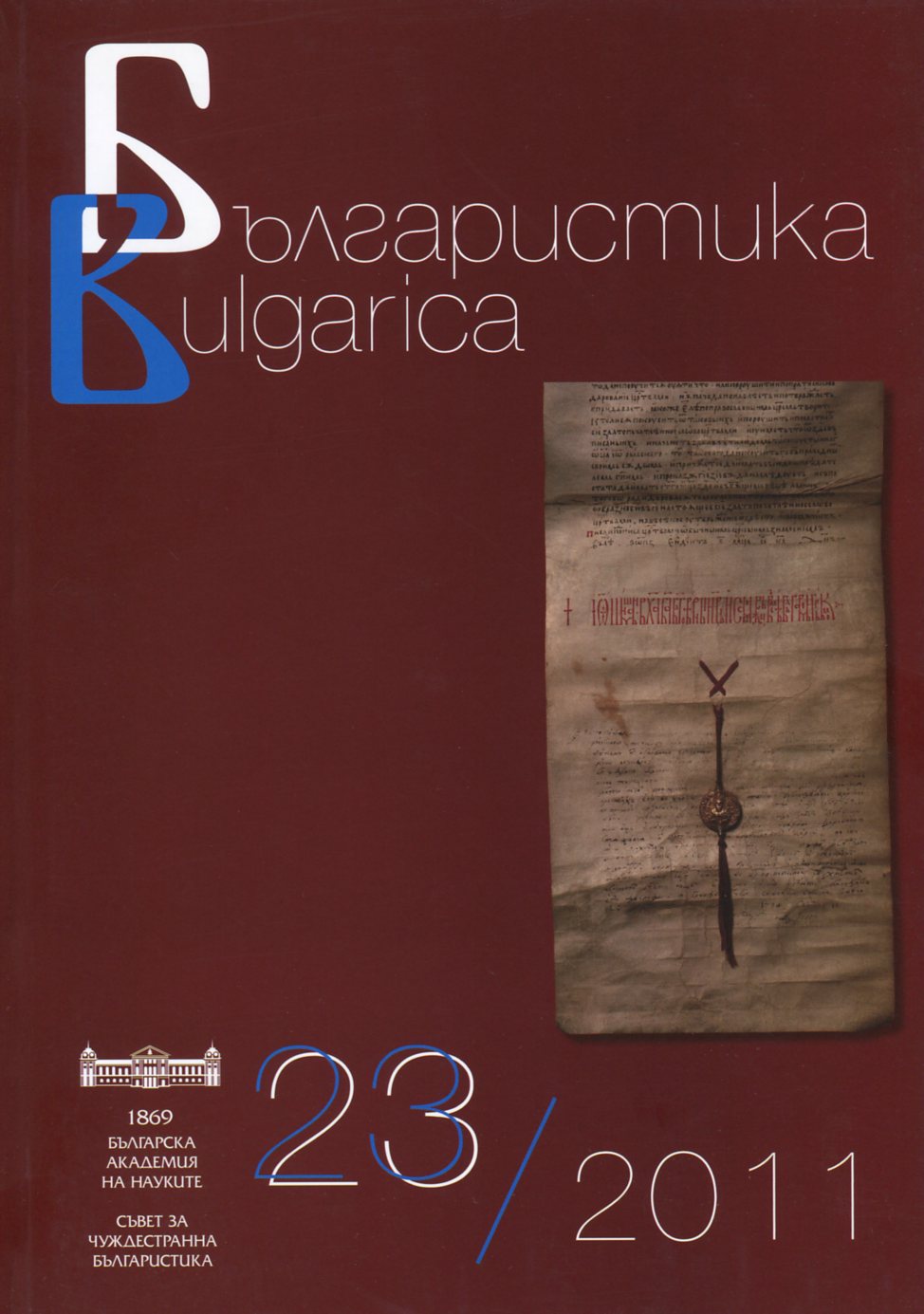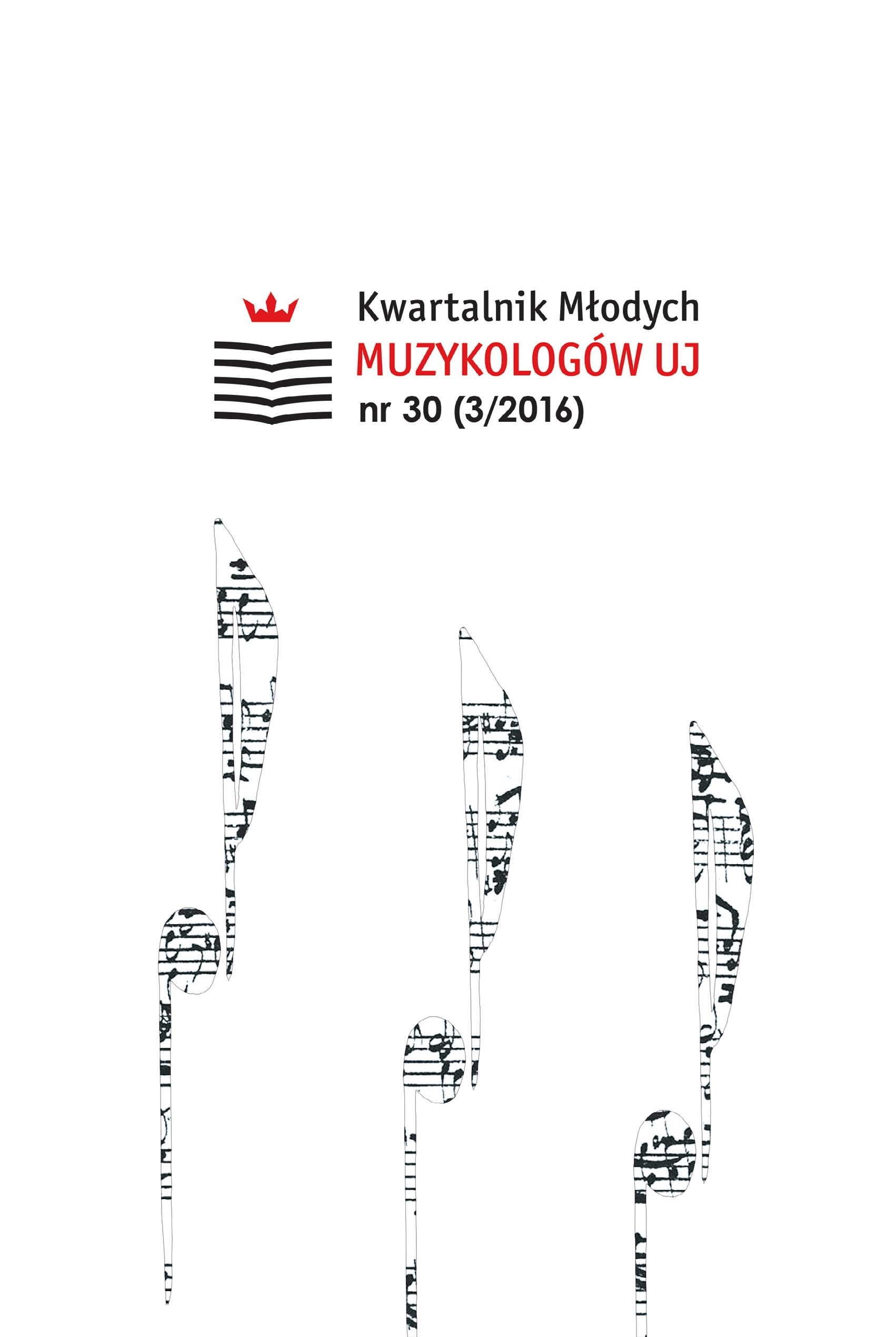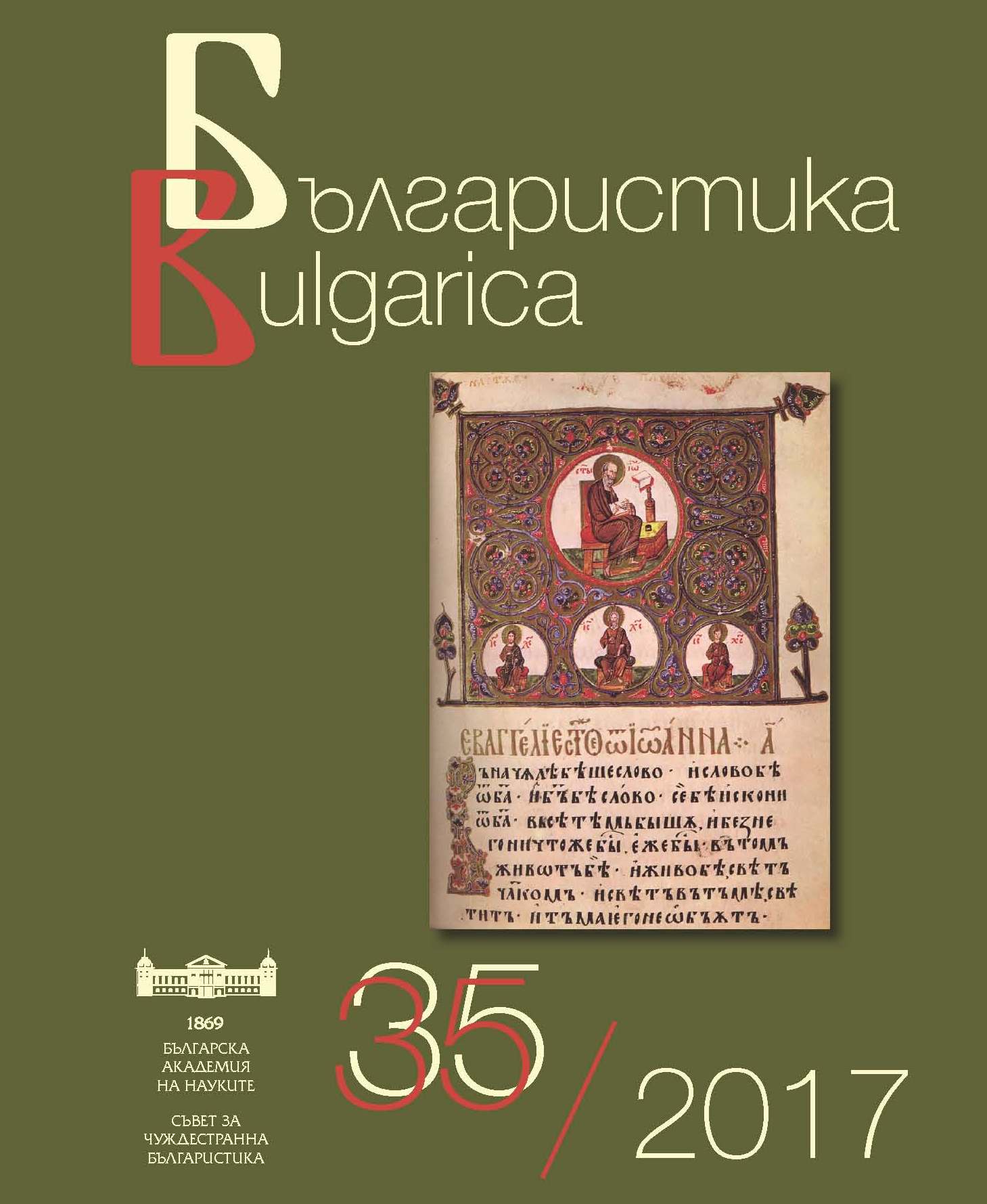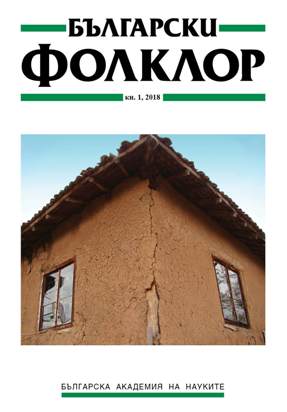
We kindly inform you that, as long as the subject affiliation of our 300.000+ articles is in progress, you might get unsufficient or no results on your third level or second level search. In this case, please broaden your search criteria.


Parfianowicz-Vertun examines the role of literacy practices and verbal creativity in Czech underground culture. She focuses on ways in which underground artists used writing and the written words; the tension between writing and alternative culture, which was largely based on the spoken word; as well as situations in which the act of writing became a performance of sorts. The article explores various aspects of underground culture: music, poetry, fine art and samizdat publishing.
More...
Selected bibliography in the field of Bulgarian Studies published in the current year
More...
Defended PhD theses in Bulgaria in the field of linguistics, literature, history, folklore, ethnography and art studies
More...
This paper examines the relationship between Bachelard’s (Gaston Bachelard, 1884–1962) philosophical comprehension of the water element, Debussy’s (Claude Debussy, 1862–1918) musical interpretation of the water phenomenon and Thaulow’s (Frits Thaulow, 1847–1906) intellection of the same element in painting. More precisely, having in mind the snow as one of aggregate states of water, I will explore via examples of Bachelard’s study on water and dreams – L’eau et les rêves essai sur l’imagination de la matière (Water and Dreams. An Essay on the Imagination of Matter, 1942), Debussy’s composition Des pas sur la neige (Footprints in the snow, Book I, 1909–1910) and Thaulow’s piece La Rivière Simoa en hiver (Winter at Simoa river – from a series of images of the Simoa river, unknown date), the reciprocal relationship of their artistic perception, as well as their interpretation of the water phenomenon. These three authors have devoted a significant “expanse” of their oeuvres to their interpretation of the phenomenon of water. In the mentioned “expanse”, their creative interpretations encounter, intertwine, and interrelate. In other words, in this “expanse” of interpretation of the water psyche, we can detect the correspondence between Bachelard’s, Debussy’s and Thaluow’s poetics of the water vastness. Therefore, through the analytical and comparative approaches, my aim is to emphasize the correspondence among Bachelard’s (philosophical), Debussy’s (musical) and Thaulow’s (painterly) representations of the water element and to demonstrate which compositional and expressive methods Debussy employs to embody his understanding of the phenomenon in question.
More...
The culture of Georgian chant is variable and particular schools are different from each other. The vital schools are Gelati, Shemoqmedi (West Georgian chant traditions) and Karbelashvilebi (East Georgian chant traditions). The paper presents musical analysis of West Georgian chant traditions, using Gelati school as an example. Scores are taken from Georgian musical manuscripts from the 19th century, which are saved in National Centre of Manuscripts and were written by St. Pilimon the Chanter (Koridze) and St. Ekvtime the Confessor (Kereselidze). The article’s aim is to show how some of the Great Feasts in Georgia were celebrated. The first part contains the examination of some individual aspects of Georgian liturgical practice. The second part synthetises what is important in the process of researching Georgian chant. The analysis shows individuality of the chant material. Diversity and abundance of existing materials gives the opportunity to conduct further research on the topic.
More...
The aim of an article is to show a strategy of creating brand by Metropolitan Opera according to the theory of global culture industry by Scott Lash and Ceila Lury. The main process which plays a significant role in this strategy is a medialisation of the opera, which provides constant update of this genre and helps it to adapt its form for a contemporary consumer. This strategy changes the relation between product and its recipient on several levels and makes an opera a new, fresh and modern music genre, as well as a theatrical and cinematic experience. Expansive Met brand transforms the operatic industry and introduces numerous innovations as Live in HD, iPod applications, Met on Demand, a brand of a singer etc. There’s also a significant aura around this brand, which imposes a form of thinking and causes certain expectations in relation to the consumer goods made by Met. According to the Roland Barthes’ theory of modern myth, the perception of this brand depends also on its history, memory and tradition, as well as being created by the identity itself. Thanks to the innovations and the nature of the event, an access to the opera nowadays is much easier and becomes a sign of a modern era.
More...
The Gospel According to St. Matthew (1964) was the third film made by an Italian intellectual Pier Paolo Pasolini. After many scandals and court trials which concerned seditious character of his earlier shortmovie La ricotta (making part of Ro.Go.Pa.G., 1963), he decided to dedicate his new film to the history of Christ, choosing the text of The Gospel According to St. Matthew, naming it the one which in the best way represents the human nature of Christ and his „being a man among men”. The film he made is an interesting work of art because of many reasons: it was filmed in the area of the South of Italy, it’s maintained in the neorealism aesthetics, and thanks to the actors who starred in the film (one of the Apostles was played by Giorgio Agamben, an Italian philosopher, Jesus was played by a Spanish student, a strong follower of communism and Mary was played by Pasolini’s own mother – Susanna). Nevertheless, The Gospel According to St. Matthew, among other Pasolini’s film, has the most complex and refined soundtrack list, because this time, the music is the element which plays the major role in the film, being the factor of the stylistic contamination he applied in his works. The story of Christ is portrayed by unusual music choices such as Sometimes I Feel Like a Motherless Child by Odetta Williams, Gloria from the Kongo mass Missa Luba, Prokofiev’s Alexander Nevsky and others. Thus, it is important to have a closer look at the film’s music, and by decoding the intertextual figures such as quotations and allusions, try to understand its narrative symbolism and hidden, autobiographical motives created by Pasolini.
More...
„La buona figliuola” („The Accomplish’d Maid”) is an opera buffa in three acts by Niccolò Piccinni and Carlo Goldoni. The librettist based his text on Samuel Richardson’s novel „Pamela, or Virtue Rewarded”. It was performed for the first time at the Teatro delle Dame, Rome on 6th February 1760 with an all male cast. It was a big success and „La buona figliuola” took Europe by storm. Every European opera house had this opera in its repertoire. The performances were in: Barcelona, Prague, Vien, Dresden, London, Berlin, Mannheim and Paris. This opera was probably performed even in Beijing by Jesuits in 1778. „La buona figliuola” was so popular in Europe that Stanisław August Poniatowski, the King of Poland, wished it for his coronation ceremony. The performance took place at the National Theatre on 7th August 1765, just five years after the world premiere. This opera was also very popular in Warsaw. People loved the story of a simple and good maid Cecchina. Seventeen years later, Wojciech Bogusławski, the director of the National Theater, translated and adapted Goldoni’s opera and named it „Czekina albo cnotliwa panienka” („Czekina or a Virtuous Maid”). He performed it in 1782 with big success. First of all, the article describes the historical context of the creation of libretto – the Carlo Goldoni’s biography. Next, it presents the story of maid Cecchina and the phenomenon of the description of the Polish theories of translation from the 18th century, the Polish version of the opera – „Czekina or a Virtuous Maid”, is presented. Finally, two versions of the libretto – the Goldoni’s and the Bogusławski’s, are compared.
More...

This publication presents a research on students – future teachers – and their pedagogical skills in terms of theoretical and practical musical training. Some points of view on the current topic are considered in the theoretical part. The result of the theoretical research on the problem has been determined by the nature of the musical and pedagogical skills. The opportunities for assessing student’s pedagogical skills at theoretical and practical trainings are displayed in the practical-applying section. The methods, used in this research are: theoretical analysis of the literature on the studied problem, qualitative analysis of results from the research, relative to the musical practical preparing of students from the Primary School Pedagogic.
More...
HOLEC, ROMAN. ČLOVEK A PRÍRODA V „DLHOM“ 19. STOROČÍ; KIANIČKA, DANIEL HAAS (ED.). MUSEION. ZBORNÍK KREMNICKÉHO MÚZEA; BYSTRICKÝ, PETER. PES V MYTOLÓGII, NÁBOŽENSTVE A FOLKLÓRE STAROVEKU A STREDOVEKU; DASZEWSKA, MARZENA (ED.). KOSZYCKA MODERNA / KOŠICE MODERNISM; ĎUĎÁKOVÁ, MONIKA – POČÁTKO, MARTIN (EDS.). MIGRAČNÉ PROCESY V DEJINÁCH EURÓPY. KRÍZA ALEBO ÚSVIT CIVILIZÁCIE? STRETNUTIE MLADÝCH HISTORIKOV VI.
More...
Content of the main Bulgarian scientific journals for the current year in linguistics, literature, history, folklore, ethnography, archaeology and art studies.
More...
Scientific Life; Scholarly Conference
More...
This article presents three interrelated studies on the use of gestures by children, university students and teachers who apply the Narrative Format model for second language acquisition in their practice. The model was created by Taeschner (2005).The results of the first research project, implemented in Bulgaria and abroad, verify that using gestures facilitates and supports children’s second language acquisition.The two studies which followed were conducted among university students in pedagogy from Sofia University and language teachers from various nursery schools. Results verify the relationship between gestures, used by teachers and their registered levels of empathic concerns. Gestures are viewed as part of the Teacher Behaviour Profile. The more empathic teachers are, the more frequently they use gestures in their interactions with the children. This has a direct impact on the learning achievements of the children. Furthermore, children taught by teachers with higher levels of empathy show better results in their language acquisition.
More...
The article introduces the notion of solfeggio not only to refer to special education and educational science in music, but also as a method of study, experience and dedication in the alphabet of language and literature. For this purpose is explored how through musical approach are created words, formed by sound assimilation of actions; constructed as unmeaning musical fillings; sound imitations of the voices of animals with specific meaningful goal – bleating; sound imitation of the work of individual objects or equipment. The main objectives of verbal solfeggio is to identify learning and practical realization of harmonic music of language in its semantic and figurative rhythmic, taking into consideration the national and individual language tonality.
More...
The article deals with theoretical bases and organizational peculiarities of the movie-technology that is one of the productive innovative technologies in Russian as a foreign language instruction. This technology supposes the organizing of Russian language acquisition during the preparation of the film production, the proper film production, its montage and following viewing. The specific features of movie-technology stages in the process of instruction are described.
More...
Disability studies and critical trauma studies are both deeply concerned with the social construction of meaning and identity. However, these disciplines often remain mutually disengaged, inadvertently overlooking shared mechanisms of oppression that foster stigma. This article explores the novel depiction of disability and trauma in the play Amy and the Orphans by Lindsey Ferrentino. Amy, a character with Down Syndrome, challenges disability stereotypes by exercising autonomy; she is not solely defined by her disability or her experiences of abuse. The theatrical narrative is one of both disability and trauma, encouraging a nuanced reflection on the origins of stigma and revealing how theatre can be used as a tool of resistance to reclaim agency through performances that challenge conventional ‘disability’ stereotypes.
More...
The focus of the article is on the recent past – the era of socialism, and especially on the goods for mass consumption. In spite of the fact that the objects are not ideologically burdened, their nowadays’ fate is very interesting – they are one of the main transmitters of the feeling of nostalgia about a simpler and better life in the past. No more part of people’s style of living, they are nevertheless rich in personal memories. Such presence provokes a lot of reminiscences and imaginations about slow and safe but already irrevocably lost life. Exploiting nostalgic feelings among big groups in Bulgarian society, nowadays market actors create special places full of objects of the recent past. Two of them – Raketa restaurant and Com.bar in the centre of the city of Sofia are very representative places for entertainment. This is the reason they to be on the focus of the anthropological fieldwork.
More...